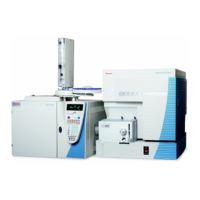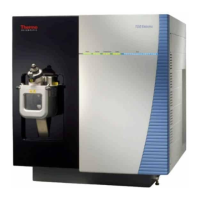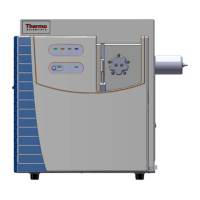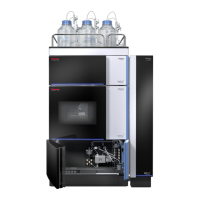1
Introduction
Scan Types
10 TSQ Series Hardware Manual Thermo Scientific
Scan Types
TSQ systems can be operated with a variety of scan types. The most common scan types are as
follows:
• Full Scan
• Selected Ion Monitoring (SIM)
• Selected Reaction Monitoring (SRM)
• AutoSIM
Full Scan
The full-scan scan type provides a full mass spectrum of each analyte. With full scan, the
scanning mass analyzer is scanned from the first mass to the last mass, without interruption,
in a given scan time.
Full-scan experiments are used to determine or confirm the identity of unknown compounds
or the identity of each component in a mixture of unknown compounds. (Generally, a full
mass spectrum is needed to determine the identity of an unknown compound.)
The full-scan scan type gives you more information about an analyte than does SIM, but a full
scan does not yield the sensitivity that the other two scan types can achieve. With full scan,
you spend less time monitoring the signal for each ion than you do in SIM or SRM. Full scan
provides greater information but lower sensitivity than the other two scan types.
To use the SIM or SRM, you need to know what ions or reactions you are looking for before
you can perform an experiment with these scan types. Thus, you might use a full scan for SIM
to determine the identity of an analyte and to obtain its mass spectrum and a full scan for
SRM to determine the mass spectrum and product mass spectra for parent ions of interest.
Then, you might use SIM or SRM to do routine quantitative analysis of the compound.
Selected Ion Monitoring
Selected ion monitoring (SIM) monitors a particular ion or set of ions. SIM experiments are
useful in detecting small quantities of a target compound in a complex mixture when you
know the mass spectrum of the target compound. Thus, SIM is useful in trace analysis and in
the rapid screening of a large number of samples for a target compound.
Because SIM monitors only a few ions, it can provide lower detection limits and greater speed
than the full-scan modes. SIM achieves lower detection limits because more time is spent
monitoring significant ions that are known to occur in the mass spectrum of the target
analyte. SIM can achieve greater speed because it monitors only a few ions of interest; SIM
does not monitor regions of the spectrum that are empty or have no ions of interest.

